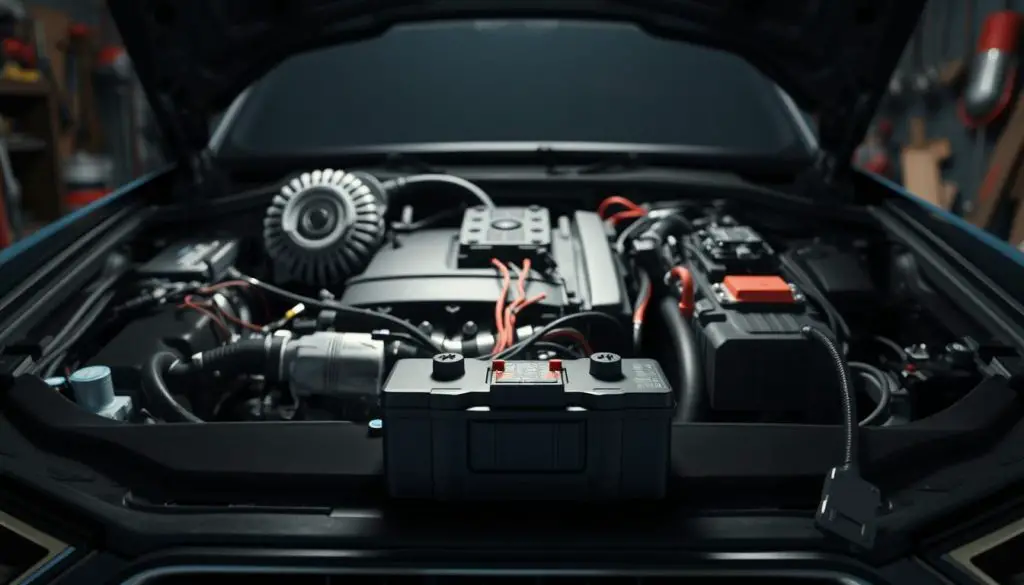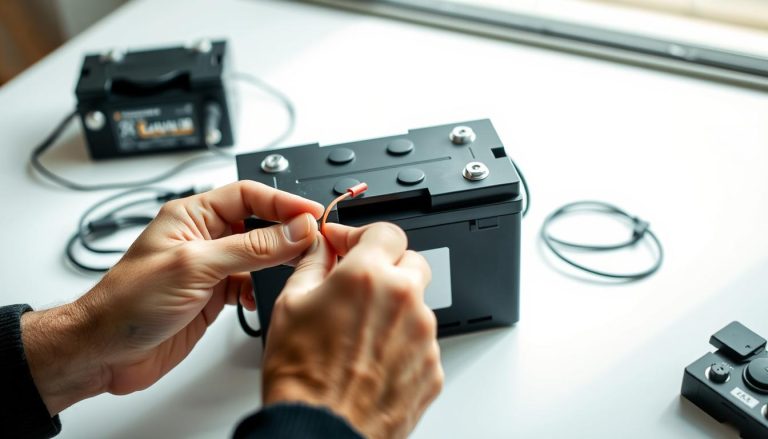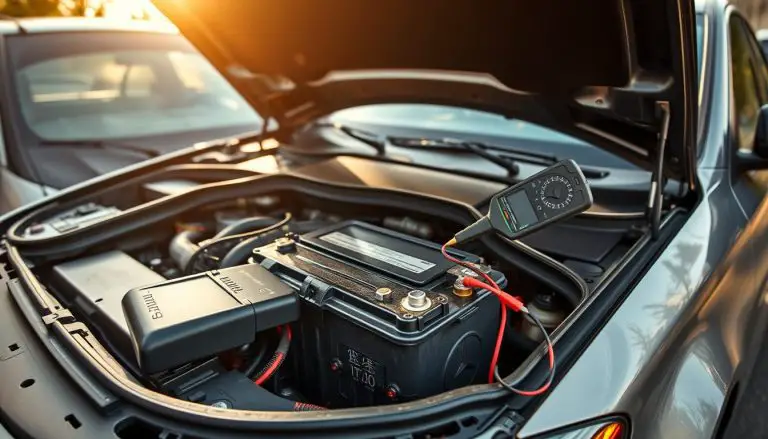Owners of Audi vehicles may experience battery discharging issues even when their car is stopped. This problem can be frustrating and may leave drivers wondering about the underlying causes and potential solutions.
The issue of battery drain can be attributed to various factors, including electrical system malfunctions, user behavior, and design characteristics of the vehicle. Understanding these factors is crucial for fixing Audi battery issues and preventing future occurrences.
Key Takeaways
- Identify common causes of Audi battery discharging while stopped.
- Learn how to diagnose battery drain issues in your Audi.
- Discover effective solutions for fixing Audi battery problems.
- Understand the importance of regular vehicle maintenance.
- Find out how to prevent battery discharging issues in the future.
Understanding Audi Battery Systems
Understanding the intricacies of Audi’s battery systems is crucial for maintaining your vehicle’s health. Audi’s advanced electrical systems are designed to provide a seamless driving experience, but they can be complex.
How Modern Audi Electrical Systems Work
Modern Audi vehicles rely on sophisticated electrical systems that power various components, from the infotainment system to the vehicle’s starter motor. The electrical system is managed by a network of control units that monitor and control the flow of electrical current.
Normal vs. Abnormal Battery Discharge Rates
Battery discharge is a normal occurrence in any vehicle. However, abnormal discharge rates can indicate a problem. Key signs of abnormal discharge include:
- Dim or flickering headlights
- Slow engine crank
- Frequent jump-starts
Differences Between Audi Model Battery Systems
Audi models vary in their electrical system configurations. For instance, some models feature start-stop technology, which can affect battery discharge rates. Understanding these differences is key to diagnosing and fixing battery-related issues.
By grasping how Audi’s electrical systems work and what constitutes normal versus abnormal battery discharge, you’ll be better equipped to identify potential issues before they become major problems.
Audi Battery Discharging While Stopped: Causes and Solutions
Understanding the causes of battery drain in your Audi is crucial for maintaining its performance and longevity. Battery drain, or parasitic drain, occurs when there’s an abnormal discharge of the battery’s power when the vehicle is turned off. This can lead to a range of issues, from minor inconveniences to significant problems that affect the vehicle’s overall functionality.
Common Symptoms of Battery Drain
Identifying the symptoms of battery drain is the first step towards resolving the issue. Common signs include:
- Difficulty starting the engine
- Dim or flickering headlights
- Malfunctioning accessories like radios or wipers
- The battery warning light on the dashboard
These symptoms can indicate a parasitic drain, which is a continuous draw of power from the battery when the vehicle is off.
Impact on Vehicle Performance and Starting
Battery drain can significantly impact your Audi’s performance and starting capability. A drained battery can lead to:
- Slow engine crank or failure to start
- Erratic behavior of electrical systems
- Potential damage to the alternator and other components
A drained battery can leave you stranded, making it essential to address the issue promptly.
How to Identify Parasitic Drain
To identify parasitic drain, you can use a multimeter to measure the current draw on your battery when the vehicle is off. A reading above 50 mA typically indicates a parasitic drain.
| Current Draw (mA) | Indication |
|---|---|
| 0-50 | Normal |
| 50+ | Parasitic Drain Likely |

By understanding the causes and symptoms of battery drain, you can take proactive steps to diagnose and fix the issue, ensuring your Audi remains in optimal condition.
Diagnosing Battery Drain in Your Audi
To effectively diagnose battery drain, it’s crucial to understand the tools and techniques involved. Diagnosing battery drain in your Audi is a systematic process that requires the right equipment and a thorough understanding of the vehicle’s electrical system.
Essential Tools for Proper Diagnosis
Before starting the diagnostic process, it’s essential to have the right tools. These include a multimeter for measuring voltage and current, a battery tester for assessing battery health, and a scan tool like VCDS or OBDeleven for Audi-specific diagnostics.
- Multimeter
- Battery tester
- VCDS or OBDeleven scan tool
- Fuse puller
Step-by-Step Multimeter Testing Process
Using a multimeter is a crucial step in diagnosing battery drain. Here’s a step-by-step guide:
- Set the multimeter to the DC amps setting.
- Disconnect the negative battery cable.
- Connect the multimeter in series between the negative battery cable and the negative battery terminal.
- Take a reading to measure the current draw.
- Compare the reading to the manufacturer’s specifications.
Using VCDS/OBDeleven for Audi-Specific Diagnostics
VCDS and OBDeleven are powerful tools for diagnosing issues in Audi vehicles. They provide access to advanced diagnostic functions, including:
Reading and Interpreting Error Codes
These tools allow you to read and clear fault codes, providing valuable insights into the health of your Audi’s electrical system.
Module Sleep Current Testing
Module sleep current testing is a critical diagnostic function that helps identify which modules are drawing excessive current when the vehicle is in sleep mode.
| Module | Sleep Current (mA) | Status |
|---|---|---|
| Comfort Module | 0.5 | OK |
| Infotainment Module | 1.2 | High |
| Engine Control Module | 0.2 | OK |
“The key to diagnosing battery drain is to methodically isolate the source of the drain using the right tools and techniques.” – Automotive Expert
By following these steps and using the right tools, you can effectively diagnose and address battery drain issues in your Audi.
Common Causes of Battery Drain in Audis
Several factors can contribute to battery drain in Audis, ranging from hardware issues to software glitches. Understanding these causes is essential for diagnosing and resolving the problem effectively.
Problematic Control Modules
Control modules such as the MMI (Multi-Media Interface) and Comfort modules can sometimes malfunction, leading to excessive battery drain. These modules are crucial for various vehicle functions, and their failure can result in persistent power consumption even when the vehicle is turned off.
Interior Lights and Door Contact Switches
Interior lights that remain on due to faulty door contact switches or improper settings can quickly drain the battery. Ensuring that these lights turn off when the doors are closed is crucial.

Aftermarket Equipment and Improper Installations
Aftermarket equipment, if not installed correctly, can draw power from the battery even when the vehicle is off. It’s essential to ensure that any aftermarket installations are done by professionals who follow proper procedures.
Battery Age and Capacity Issues
Battery age and capacity play a significant role in its ability to hold a charge. Older batteries or those with reduced capacity are more prone to draining quickly, especially in modern Audis with advanced electrical systems.
Start-Stop System Malfunctions
The Start-Stop system, designed to save fuel by shutting off the engine during stops, can sometimes malfunction and cause battery drain. Issues with this system can lead to frequent engine restarts, putting additional strain on the battery.
By understanding these common causes of battery drain, Audi owners can take proactive steps to diagnose and potentially fix the issues, ensuring their vehicle’s battery remains healthy and functional.
DIY Solutions for Audi Battery Drain
Audi owners can tackle battery drain issues with simple, effective DIY methods. By understanding the causes and implementing the right fixes, you can prevent future battery problems and ensure your vehicle runs smoothly.
Safe Battery Disconnection Procedures
Before starting any DIY repairs, it’s crucial to safely disconnect your Audi’s battery. Always disconnect the negative (black) cable first, followed by the positive (red) cable. This prevents any accidental short circuits.
Resetting Electrical Systems and Control Units
Sometimes, resetting your Audi’s electrical systems can resolve battery drain issues. You can do this by resetting the car’s computer or removing fuses related to non-essential systems. This process can help recalibrate your vehicle’s electrical components.
Replacing Common Faulty Components
Faulty components can cause significant battery drain. Identifying and replacing these parts is crucial.
Control Module Replacement
If a control module is malfunctioning, it can continuously draw power from the battery. Diagnosing the issue with a multimeter or VCDS/OBDeleven can help identify the problematic module. Replacing it can resolve the battery drain.
Battery Replacement Guidelines
If your Audi’s battery is old or weak, replacing it might be necessary. Ensure you choose a battery compatible with your vehicle’s specifications. Proper installation is key to avoiding further issues.
Battery Maintenance and Charging Best Practices
Regular battery maintenance is essential. Keep the terminals clean, check the electrolyte levels (if applicable), and avoid deep discharging. Using a battery tender or maintenance charger can also help prolong battery life.
By following these DIY solutions, Audi owners can effectively address battery drain issues and maintain their vehicle’s health.
Preventive Measures to Avoid Future Battery Issues
Proactive care is essential for extending the life of your Audi’s battery and preventing unexpected discharge issues. By adopting a few simple practices, you can significantly reduce the risk of battery-related problems.
Regular Battery Health Checks
Regular checks are vital to ensure your battery is in good condition. This includes inspecting the battery terminals for corrosion and checking the battery’s state of charge. Using a multimeter to test the battery voltage can provide insights into its health.
Proper Vehicle Storage Procedures
If you plan to store your Audi for an extended period, proper storage procedures are crucial. This includes disconnecting the battery or using a battery maintainer to keep the battery charged. Storing the vehicle in a cool, dry place can also help preserve the battery’s health.
Battery Tenders and Maintenance Chargers
Battery tenders and maintenance chargers are designed to keep your battery at an optimal charge level. These devices can be particularly useful for vehicles that are not driven frequently.
Software Updates and Their Importance
Regular software updates for your Audi’s electrical systems can help prevent battery drain issues caused by software glitches. Ensuring your vehicle’s software is up-to-date is a critical preventive measure.
| Preventive Measure | Description | Benefit |
|---|---|---|
| Regular Battery Checks | Inspect battery terminals and state of charge | Early detection of potential issues |
| Proper Storage | Disconnect battery or use a maintainer | Prevents deep discharge |
| Battery Tenders | Keep battery at optimal charge | Extends battery life |
| Software Updates | Update electrical system software | Prevents software-related drain |
Conclusion
Proper Audi battery maintenance is crucial to prevent battery drain and ensure the longevity of your vehicle’s electrical system. As discussed, various factors can cause battery discharge while stopped, including problematic control modules, interior lights, and aftermarket equipment.
To maintain your Audi’s battery health, regular checks and proper vehicle storage procedures are essential. Using a battery tender or maintenance charger can also help prevent battery drain. For more information on charging car batteries while driving, visit Renogy’s guide on the topic.
By following the DIY solutions and preventive measures outlined in this article, you can identify and address potential issues before they become major problems. Regular software updates and inspections can also help maintain your Audi’s electrical system.
By prioritizing Audi electrical system care and battery maintenance, you can ensure your vehicle remains reliable and performs optimally.
FAQ
What are the common causes of Audi battery draining while stopped?
Common causes include problematic control modules, interior lights and door contact switches left on, aftermarket equipment, battery age and capacity issues, and start-stop system malfunctions.
How can I diagnose battery drain in my Audi?
Diagnosing battery drain involves using a multimeter to measure battery voltage and current draw, checking for parasitic drain, and using VCDS/OBDeleven for Audi-specific diagnostics to read error codes and perform module sleep current testing.
What is the best way to maintain my Audi’s battery health?
Regular battery health checks, proper vehicle storage procedures, using battery tenders and maintenance chargers, and keeping your Audi’s software up to date can help maintain battery health.
Can aftermarket equipment cause battery drain in my Audi?
Yes, aftermarket equipment can cause battery drain if not installed correctly or if it’s not compatible with your Audi’s electrical system.
How do I know if my Audi’s battery needs to be replaced?
Signs that your Audi’s battery may need replacement include age (typically after 5-7 years), reduced battery capacity, and difficulty starting the engine.
What is the proper procedure for disconnecting my Audi’s battery?
To safely disconnect your Audi’s battery, ensure the ignition is off, remove the negative (black) cable first, and then the positive (red) cable, taking care not to touch any metal parts with the cables.
Can a faulty start-stop system cause battery drain?
Yes, a malfunctioning start-stop system can cause excessive battery drain due to its increased demand on the battery.
How often should I perform battery maintenance on my Audi?
It’s recommended to check your Audi’s battery health every 6-12 months, or as specified in your owner’s manual, to ensure optimal performance and longevity.



